
Even though there’s a polar blast going through this area right now, it’s been a fun weekend/ week. All sorts of films are getting finished through cleanup for various sets, and I’ve been able to get the finishing touches on the Odds & Ends set.
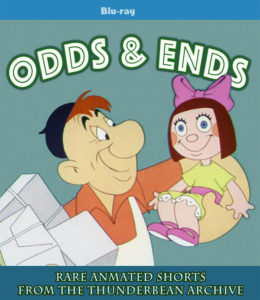 Originally there Odds & Ends project started out as one of the ‘special’ sets, but the film scans looked so nice that it made some sense to clean them up and make the set a little more widely available. We’ve just finished dubbing all the pre-orders, and it’s now available on Amazon. It’s a sort of ‘semi-official’ Thunderbean set, but likely a limited edition. It was so much fun to put this collection together, especially in getting really nice scans of some of these films.
Originally there Odds & Ends project started out as one of the ‘special’ sets, but the film scans looked so nice that it made some sense to clean them up and make the set a little more widely available. We’ve just finished dubbing all the pre-orders, and it’s now available on Amazon. It’s a sort of ‘semi-official’ Thunderbean set, but likely a limited edition. It was so much fun to put this collection together, especially in getting really nice scans of some of these films.
Here’s the films that are on the set, some available before, others new.
Why Play Leapfrog (1948, John Sutherland productions). Part of a series of beautifully animated propaganda cartoons produced for Harding College, this slick Technicolor production explains how raw materials are turned into products through labor, featuring a Private Snafu-esque character ‘Joe’.
Sammy Salvage (1943, Ted Eshbaugh). A toddler-sized Uncle Sam promotes scrap drives in this short oddity sponsored by the War Activities committee. Scanned from the only-known 35mm Technicolor print at the Library of Congress.
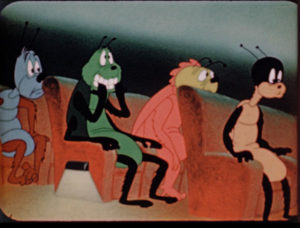
“Doomsday For Pests”
Willi Schmierfink’s Abenteuer – (1929/Paul Peroff) and Willi’s Zujunfts-Traum (1930/Paul Peroff). Two rare, early shorts by German animator Paul Peroff.
Jim and Judy in Teleland (1950 /Paul Paroff) A rare episode from one of the first series produced for television. Saved from complete obscurity by collector Chris Sobieniak.
Little Orphan Annie (c. 1934) Odd little short, likely produced as a demo by small animation producer John (Scarfoot) McCrory. It found its way onto 16mm for the toy film market in the late 30s into the 40s.
PM Picnic (1948, Chad/ Al Stahl). This short was produced to show to distributors and stores at product shows, touting the great selling value of the magazine ads featuring cute animals selling ‘PM’s Famous Blended Whiskey’. Stahl recalled making this film in about two weeks.
An Egyptian Gyp (1930 / George Jeffrey). Early ‘Kolortone’ sound cartoon that seems to only survive in this green tinted, silent print. Nicely illustrated cutouts comprise the majority of the animation in this film.
A Fable of the New Deal (1935/36, Ted Eshbaugh). Rare propaganda short produced by Eshbaugh for the US 1936 election. A longer version of this political short remains at large.
The Enemy Bacteria (1945/ Walter Lantz productions). Beautifully produced 28 minute live action/ animated short produced for the US Navy.
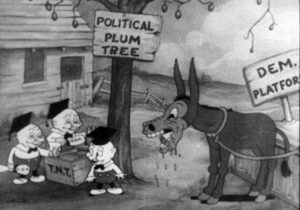
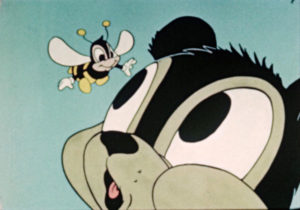
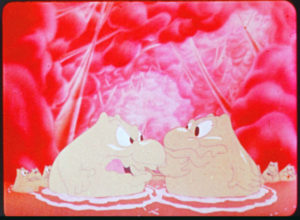
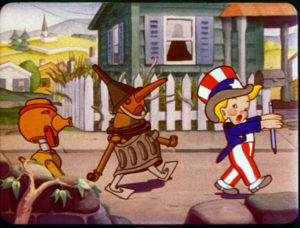
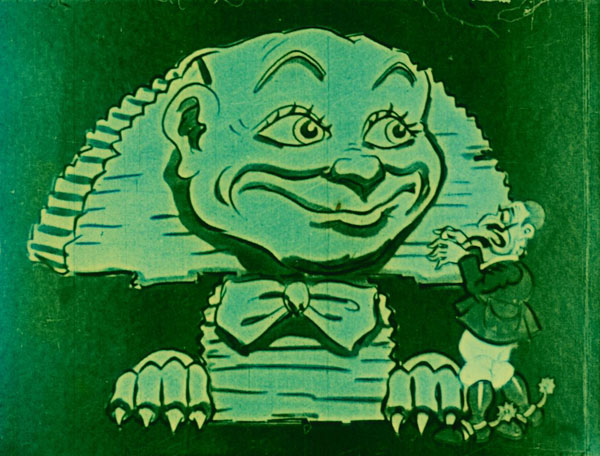
“An Egyptian Gyp”

Why Play Leapfrog (1948) may be my favorite of the films produced by John Sutherland Productions. The studio was comprised of experienced animators, supplemented by various freelancers moonlighting on these projects after their regular day jobs. Animator Ken Southworth told me there was always a good amount of freelance work to be found from whatever ‘industrial’ Sutherland was producing. He mentioned that more than a few people he knew had worked on the films, even while he was at Disney. He had thought that MGM may have done some of the production work on the films, although I have yet to see any documentation about that.
 I think I like this particular film the best because its one of the least political, having more of a basis in fact rather than fear. Harding College paid for the series to be produced in grand style, with appealing, full animation throughout.
I think I like this particular film the best because its one of the least political, having more of a basis in fact rather than fear. Harding College paid for the series to be produced in grand style, with appealing, full animation throughout.
John Sutherland worked from 1938 into mid-1940 at Disney, working as an assistant to David Hand on Bambi as well as voicing the adult Bambi in the film.
Sutherland produced the low-budget ‘Daffy Ditties’ series for United Artists from 1945 to 47. The Lady Says No (With work by Wah Ming Chang and directed by Frank Tashlin). I haven’t seen any of the other Daffy Ditties though I know some were stop motion and others were traditional hand drawn.
Here’s another film directed by Frank Tashlin with stop motion by Way Ming Chang, The Way of Peace (1947), restored by UCLA a few years back. This film was produced by East/West productions for Christian Films, and distributed to Churches in the late 40s.
Carl Urbano became lead director on animated projects at Sutherland sometime around 1949; my guess is that he may have directed some of the earlier films as well. Urbano had worked at MGM/ Harman/ Ising from the early 30s into the mid 40s, working on ‘Winky the Watchman’ and ‘Easy Does It’ as well as other projects for Hugh Harman later on, then onto Sutherland for the Harding College Series. He stayed at Sutherland at least into the early 60s.
 Ron Hall posted a nice article about Carl Urbano here in 2015 with more details.
Ron Hall posted a nice article about Carl Urbano here in 2015 with more details.
Many former MGM artists worked at the Sutherland Studio as both freelancers and full time. MGM animator George Gordon may very well have directed the Harding College 1948 series, including this title. Other animators from this period include Preston Blair, Bill Higgins and Arnold Gillespie. Some of these same animators freelanced for Sutherland for many years. Can you recognize any of the animators in this (uncredited) short?
If you look on the internet, you’ll see that some sources list Bill Hanna/ Joe Barbara as directors of at least one of them. I think it’s very clear that this isn’t the case in both the direction, design or any further documentation. My guess was that someone saw that MGM had released some of these films theatrically and made the assumption they were made at MGM’s animation department.
I first saw this film in the early 80s when I bought a nice 16mm blue track Technicolor print. It was beautiful but a bit soft. I bought another print a year or so later from longtime film collector/ dealer JG (Jerry) Nelson, and that’s the same print I scanned this year and cleaned up here. It’s still appealing and fun, and the propaganda is at least a little more tolerable in this short.
What are your thoughts on this film, and what are your favorites among Sutherland’s shorts?
Have a good week everyone!


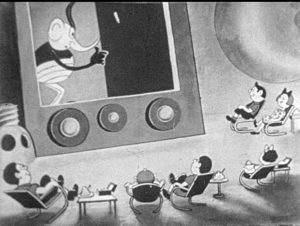
 Steve Stanchfield is an animator, educator and film archivist. He runs Thunderbean Animation, an animation studio in Ann Arbor, Michigan and has compiled over a dozen archival animation DVD collections devoted to such subjects at Private Snafu, The Little King and the infamous Cubby Bear. Steve is also a professor at the College for Creative Studies in Detroit.
Steve Stanchfield is an animator, educator and film archivist. He runs Thunderbean Animation, an animation studio in Ann Arbor, Michigan and has compiled over a dozen archival animation DVD collections devoted to such subjects at Private Snafu, The Little King and the infamous Cubby Bear. Steve is also a professor at the College for Creative Studies in Detroit.






















What episode of Jim and Judy in teleland is on the set?
Given I provided it, it’s the 8th episode, “The Kangaroo Boxing Match”.
“Destination Earth” is my favourite Sutherland cartoon. The designs are imaginative and there’s a nice strain of humour throughout.
“A is for Atom” has those cool periodic table characters.
I have a soft spot for “Your Safety First.” It’s very Jetsons-like and Marvin Miller even sounds like George O’Hanlon.
“Little Orphan Annie (c. 1934) Odd little short, likely produced as a demo by small animation producer John (Scarfoot) McCrory. It found its way onto 16mm for the toy film market in the late 30s into the 40s.”
Steve, how is Little Orphan Annie presented on your set? The only version I’ve seen of this rare little cartoon is a YouTube upload posted by Tommy Stathes many years ago: https://www.youtube.com/watch?v=ybajRuGU_WY Is the version on the set the same — silent, and lasting for around 40 seconds? I hope at least the contrast and light is better adjusted on your Blu-ray edition, so it’s possible to see what’s happening.
That cartoon could have been made around 1926 or so. If McRory was responsible, it probably predated a series he did for Educational Pictures, “Life Cartoon Comedies”.
I’m also thinking 1934 sounds too late, especially because the sequence from Harold Gray’s original comic strip which this cartoon is based on (a storyline where Annie finds work in a circus) ran in newspapers around 1926-27. So, your estimate of about 1926 feels much more logical to me.
There are (were?) a couple of screenshots of the Annie cartoon that looked pretty good on either the IAD or blu-ray forum. Can’t seem to find a direct link at the moment.
Hoping my pre-order of this (along with several other sets) hasn’t mysteriously vanished on its transatlantic voyage here. Looking forward to all these rarities as usual!
34 *may* be too late, but I think 32 would be too early based on other films of McCrory.
I believe this was only demo footage, and that a final film was never produced. Somehow it ended up being sold for toy films. It looks much later than his ‘Life‘ comedies from 27, as well as later than McCrory’s ‘Buster Bear’ cartoon (1930) produced for Vitaphone, and later than Korn Plastered in Africa (1931) as well as the educational film he made on consumption (1932).
It has some of the ‘cutout’ look he employed in this later production. Some of the animation here is much more advanced than any of those films, so I was guessing it was a failed demo of sorts (the odd stills and editing almost suggest that as well). It could very well be earlier, but look at some of the animation in the life cartoons; you won’t find anything as well drawn or animated as the elephant or the Monkey rubber hosing some knife flinging. It’s a bit of a mystery…
Thanks for the tip, dbear! I googled “Orphan Annie” + “Thunderbean” and was able to find two HD screenshots in this IAD thread: https://www.intanibase.com/forum/posts/t4044-STILLS-from–Thunderbean-Thursday-2017
Turns out the Annie cartoon has already been released by Steve on the “Thunderbean Thursday 2017” Special Disc. These two screenshots certainly look MUCH better than the old YouTube upload.
http://i.imgur.com/zrk6U64.jpg
http://i.imgur.com/9G2hdN4.jpg
My three favorite Sunderland films of all time are:
“Rhapsody In Steel” from 1959,
“It’s Everybody’s Business” from 1956
“Destination Earth”
Rhapsody is one of my favorite documentary films of all time and in my opinion one of the most spectacular uses of modern animation ever!
I’ve had a lovely blue track Tech print of LEAPFROG for many years and, yes, it is just about my favorite of the Sutherland films too. Love that you included a frame grab of one of my favorite details from the film… the gum chewing toy store clerk!
And PM PICNIC is another fave for, shall we say, all the wrong reasons! Fell in love with it decades ago when our friend Jeff Missinne screened me his print.
My favorite John Sutherland films are:
“It’s Everybody’s Business”
“Destination Earth”
“What Makes Us Tick”
“Rhapsody In Steel”
Man, I’d really, really love a John Sutherland bluray, Steve.
Among others, which you’ve already put out on bluray, I own 16mm copies of
“What Makes Us Tick” made for the NY Stock Exchange, and
“The Voice Of Your Business” made for Bell Telephone.
I’ve never been able to find any information on “The Voice Of Your Business”.
I don’t know what info you need on “The Voice of Your Business,” Tony. It won a “Chris” award at the 1958 Columbus Film Festival. I’d love to see it.
Right on! Just ordered a copy on Amazon! Thanks for making this available!
The music score for “Why Play Leapfrog?” sounds a lot like the work of Disney composer Paul Smith. Would he had freelanced on projects such as this too?
Having also watched “The Way of Peace”, I find it very relevant to our modern times, particularly the part about building walls and acting out of fear.